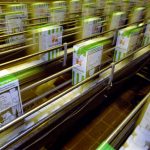 AI has become increasingly prevalent in manufacturing, but to date most of the developments have been in areas such as warehousing or maintenance. So it’s interesting that the University of Nottingham are using AI to ensure that food manufacturing equipment is kept clean.
AI has become increasingly prevalent in manufacturing, but to date most of the developments have been in areas such as warehousing or maintenance. So it’s interesting that the University of Nottingham are using AI to ensure that food manufacturing equipment is kept clean.
The system consists of an array of sensors that can ensure equipment is kept clean and hygienic. The team believe it can save up to £100m a year in the UK alone.
Detecting dirt
Maintaining hygienic equipment is a major challenge for the industry, with existing methods unable to accurately reveal just how dirty equipment is. Cleaning the equipment can be incredibly resource intensive, both in terms of the water used and the time taken.
“To prevent product contamination, many food and drink manufacturers use a non-invasive, Clean-in-Place (CIP) system to wash inside food processing equipment without disassembling it. As CIP has to operate ‘blind’, it is designed for the worst case scenario. In daily use this often results in the over-cleaning of production lines,” the team say.
The new process will be tested in an experimental rig that is being constructed in the lab to reproduce the cleaning processes used in factories.
Food inspectors
Central to the project will be an AI inspection system capable of measuring how much food remains in the rig before, during and after it’s cleaned.
The researchers are working closely with industrial partners and hope that at the end of their year-long study they will be able to produce marketable software that will process the data generated by the sensor network.
This will allow the cleaning process to be optimized autonomously by the so called Self-Optimising-Clean-In-Place (SOCIP) system, thus hopefully making it much more effective and efficient. The team believe that such a breakthrough would be a world first.
“Due to the technical complexity of sensor integration such a solution does not yet exist. The aim of the SOCIP project is to overcome these technical barriers and reduce cleaning time and resource use by approximately 20-40 per cent,” they say.
Another nice feature of the technology is that it could be retrofitted to existing equipment as well as built into newer products, thus making the market potential considerable. It should be a project to follow with interest.